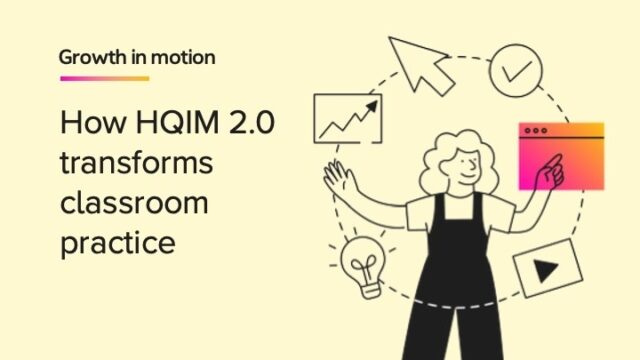
All great teachers want what’s best for their students and part of that means being able to lead and guide them through the day with engaging lessons. But how do you know if your students are engaging with you in the classroom? How do you know if your strategies are working?
Fortunately, there are some indicators of student engagement that can give you a pretty good idea of whether you’re on the right track or not.
What is student engagement in the classroom?
One definition of student engagement is when students are actively involved in their learning, feel connected to their school environment, and are motivated to participate in meaningful academic and social experiences. The goal of engagement is to keep students interested in learning and inspire them to become lifelong learners.
Jennifer A. Fredricks, a professor of Human Development at Connecticut College and researcher of student engagement expanded her interpretation to include three different types of student engagement: emotional, behavioral, and cognitive.
- Emotional engagement refers to students’ feelings about their teacher, classroom, and general school experience, as well as their sense of belonging and how valuable they view their work to be.
- Behavioral engagement includes how attentive and active students are in the classroom and within the school community (e.g., their involvement in any extracurricular activities).
- Cognitive engagement refers to how intrinsically motivated and invested students are in the learning process and how much they regulate and take ownership of it.
Fredricks’ book, Eight Myths of Student Disengagement, argue that students learn best when all three areas of engagement are met.
3 indicators of student engagement
If you break down these areas into outward, observable indicators, they become much easier to comprehend. And once you know what to look for, you can more easily assess the degree of engagement that each student is demonstrating. The list below offers some ideas for how each indicator can look in a classroom.
1. Indicators of emotional engagement:
- Students smile or greet you when they enter into your classroom.
- They listen to any instructions you give. For many students, eye contact can be a sign that students are listening.
- They respond to questions and offer their own input.
- During group work, students interact well with other students and speak to each other kindly and with respect.
- The student is focused and appears interested in the work. For many students, facial expressions and tone of voice can give you insight into what your student is feeling.
- They are in good spirits and don’t appear to have become tired or frustrated by the material you presented.
2. Indicators of behavioral engagement:
- Students come to class with all their books, tablets, and other materials.
- They sit down and begin working on any review work you have assigned.
- Students listen to you and respond accordingly. For example, if you begin the class with a funny anecdote, they may laugh or groan in good humor.
- They take notes, answer questions, and participate.
- During group work, students contribute to discussions and complete their share of the work.
- Students work diligently and do their best. They are persistent, even with difficult material.
- If they have questions, they seek you out for help.
- They complete the assignment and turn it in on time.
- Students follow end-of-class instructions promptly and clean up their work areas before leaving.
3. Indicators of cognitive engagement:
- Students sit down and set out any materials that may aid them in the learning process (notebook, pen, computer, etc.).
- Students ask in-depth questions that go beyond the material presented.
- Students make connections to other ideas and offer insightful comments, pulling information from the content they previously learned.
- They go beyond the basic requirements and use any tools or methods that best enable them to complete their assignment (such as planning out the steps, drawing a picture, making a diagram or other graphic organizers, etc.). They may do a couple of extra problems or examples to better master the concept.
- They check their work after they’ve finished the assignment to see if they missed anything.
- They seek out extra material on the subject to learn more (this one may not be evident until later—for example, if you see a student with a book on a topic you recently covered).
- Students use an assignment notebook, calendar, or other organizers to make note of any remaining work.
These indicators are a great way to check if your students are engaged, but it’s important to remember that each student is different. Some students may not outwardly show their interest but they are still engaged.
You can also use attendance, completed assignments, informal assessments, and test scores to help you track student engagement. For example, you can use exit tickets to ask students what they enjoyed about the lesson or what they would like to know more about. Asking students about their engagement through surveys and questionaries can also provide valuable insight into how they view engagement.
HMH’s Classcraft is another great resource for monitoring student engagement. Classcraft offers whole-class instruction that encourages students to actively participate with interactive tools like Turn and Talk, Learning Goals, and polls. As teachers move through the lesson they receive real-time insight into student performance and readiness, allowing them to adapt to their students' needs.
Foster a more actively engaged learning environment
It is, of course, impossible to know what exactly is going on within the mind of each student. Fortunately, inner thoughts and feelings have a way of displaying themselves in outward indicators. With practice and time spent with your students, you can develop a pretty good idea of how well they are connecting with you and the material, and how they are feeling about the learning process.
It’s highly unlikely that you’ll be able to engage all students in all three areas at all times, but you can use the data you informally collect to build upon and develop a progressively more engaged classroom.
This article was adapted from a blog post initially developed by the education technology company Classcraft, which was acquired by HMH in 2023. The views expressed in this article are those of the author and do not necessarily represent those of HMH.
***
Transform your classroom and engage every student with HMH Classcraft, a solution that pairs evidence-based ELA and math content with research-based lesson plans.
Be the first to read the latest from Shaped.














